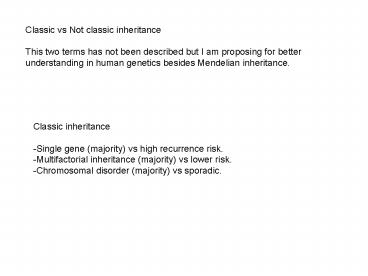Classic vs Not classic inheritance - PowerPoint PPT Presentation
1 / 34
Title:
Classic vs Not classic inheritance
Description:
Classic inheritance. Single gene (majority) vs high recurrence risk. ... Not classic inheritance ... (Most classic are rare but there may be significant cases with . – PowerPoint PPT presentation
Number of Views:70
Avg rating:3.0/5.0
Title: Classic vs Not classic inheritance
1
Classic vs Not classic inheritance This two
terms has not been described but I am proposing
for better understanding in human genetics
besides Mendelian inheritance.
- Classic inheritance
- Single gene (majority) vs high recurrence risk.
- Multifactorial inheritance (majority) vs lower
risk. - Chromosomal disorder (majority) vs sporadic.
2
Classic vs Not classic inheritance This two
terms has not been described but I am proposing
for better understanding in human genetics
besides Mendelian inheritance.
- Not classic inheritance
- Besides single gene, high recurrence risk can be
derived from other mechanisms. (some chromosomal
disorders, mitochondria,?multifactorial?) - Non-penetrance and variation in expression.
Mechanisms?
3
Besides single gene, high recurrence risk can be
derived from other mechanisms. (some chromosomal
disorders)
Blue Chr 2 Pink Chr 15
4
(No Transcript)
5
(No Transcript)
6
http//www.people.virginia.edu/rjh9u/gif/mitoped.
gif
Example of classical mitochondria inheritance
7
http//163.238.8.180/davis/Bio_327/lectures/DNA_R
epl_Chromosomes/MitoGenome.jpg
- 40 kb prokaryotic like genome.
- Oxydative phosphorylation. ATP
- Higher rate of mutation.
- Aging
http//www.sghms.ac.uk/depts/immunology/dash/apop
tosis/mito.jpg
8
http//163.238.8.180/davis/Bio_327/lectures/DNA_R
epl_Chromosomes/MitoGenome.jpg
Can you predict organs that should be affected by
mitochondria disorders?
http//www.sghms.ac.uk/depts/immunology/dash/apop
tosis/mito.jpg
9
http//163.238.8.180/davis/Bio_327/lectures/DNA_R
epl_Chromosomes/MitoGenome.jpg
Mitochondrial diseases may affect the cells of
the brain, nerves (including the nerves to the
stomach and intestines), muscles, kidneys, heart,
liver, eyes, ears or pancreas.
http//www.sghms.ac.uk/depts/immunology/dash/apop
tosis/mito.jpg
10
Homoplasmy vs Heteroplasmy
Can you explain how heteroplasmy should result to
different phenotype?
http//members.aol.com/christofmorin/img35.gif
11
- Summary characteristic of mitochondria
inheritance. - Maternal
- Heteroplasmy
- Threshold eg. Lebers optic atrophy.
- Tissue specific
http//www.aao.org/aao/education/courses/nerve/ima
ges/5-1.jpg
http//opbs.okstate.edu/melcher/MG/MGW1/i13771.gi
f
12
Depending on which cells of the body are
affected, symptoms may include Poor growth
Loss of muscle coordination, muscle weakness
Visual and/or hearing problems Developmental
delays, learning disabilities Mental retardation
Heart, liver or kidney disease Gastrointestinal
disorders, severe constipation Respiratory
disorders Diabetes Increased risk of infection
Neurological problems, seizures Thyroid
dysfunction Dementia (mental disorder
characterized by confusion, disorientation and
memory loss)
13
Example of mitochondrial diseases 14,000 (Most
classic are rare but there may be significant
cases with ..) MITOCHONDRIAL MYOPATHY WITH
DIABETES KEARNS-SAYRE SYNDROME , LEBER OPTIC
ATROPHY, PEARSON MARROW-PANCREAS SYNDROME ,
DIABETES-DEAFNESS SYNDROME, MATERNALLY
TRANSMITTED , KEARNS-SAYRE SYNDROME,
MITOCHONDRIAL MYOPATHY, ENCEPHALOPATHY, LACTIC
ACIDOSIS, AND STROKE-LIKE EPISODES MELAS,
PARKINSON DISEASE , MALIGNANT MIGRAINE
14
Example of mitochondrial disease pedigree
15
- Not classic inheritance
- Besides single gene, high recurrence risk can be
derived from other mechanisms. (some chromosomal
disorders, mitochondria,?multifactorial?) - Non-penetrance and variation in expression.
Mechanisms? - Modifier genes, Two-hits hypothesis,
Anticipation, Genomic imprinting
16
Typical pedigree of fragile X syndrome Or Sherma
n Paradox
17
www.bmb.psu.edu
Fagile X patients www.cas.bellarmine.edu
18
Triplet repeat expansion Normal DNADNADNA(cgg)6-54
DNADNADNA Fragile X DNADNADNA(cgg)200-1,300DNADNAD
NA
19
GAA, CGG, CTG mechanism of mutation causing
phenotype is different from CAG. How?
20
GAA, CGG, CTG mechanism of mutation causing
phenotype is different from CAG.
21
GAA, CGG, CTG mechanism of mutation causing
phenotype is different from CAG. How?
22
Angelman syndrome
Prader Willi syndrome
23
http//www.cytopix.com/ImageResizeCache/723578_t20
01.5.25.10.38.0_q50_600x450.jpg
24
(No Transcript)
25
(No Transcript)
26
Exp Paternal UPD 15
27
http//herkules.oulu.fi/isbn9514270274/html/equati
on77.png
28
(No Transcript)
29
(No Transcript)
30
http//herkules.oulu.fi/isbn9514270274/html/x838.h
tml
31
http//www-ermm.cbcu.cam.ac.uk/02004611h.htm
32
http//www.nature.com/nrm/journal/v4/n1/images/nrm
1008-i1.jpg
33
http//herkules.oulu.fi/isbn9514270274/html/x1212.
html
34
Classic vs Not classic inheritance This two
terms has not been described but I am proposing
for better understanding in human genetics
besides Mendelian inheritance.
- Not classic inheritance
- Besides single gene, high recurrence risk can be
derived from other mechanisms. (some chromosomal
disorders, mitochondria,?multifactorial?) - Non-penetrance and variation in expression.
Mechanisms Modifier genes, two-hits hypothesis,
triplet repeat expansion, genomic imprinting































